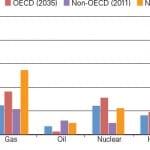Fuel for power generation will account for about 55% of demand-related energy growth through 2040, ExxonMobil forecasts in its latest annual energy forecast. Like several other forecasters, the Irving, Texas–based oil and gas company also predicts that natural gas will emerge as the leading source of electricity generation by 2040.
Among key findings in the company’s Dec. 11 release of "Outlook for Energy: A View to 2040" is that regional demand-and-supply patterns will shift in the coming decades, opening up new opportunities for international trade and economic growth. Global demand in 2040 is also forecast to be about 35% higher in 2040 than in 2010, and future energy needs will be backed by more efficient energy-saving practices and technologies, and the development of natural gas, nuclear, and renewables.
"Energy-saving practices and technologies, such as hybrid vehicles and high-efficiency natural gas power plants, will help countries in the Organization for Economic Cooperation and Development (OECD) increase economic output by 80 percent without increasing total energy use," it suggests.
Oil will keep its reign as the most widely used fuel, but natural gas is expected to overtake coal as the second-most-used fuel. Demand for natural gas will increase by about 65% through 2040, with 20% of global production occurring in North America, supported by the gas shale boom and other unconventional sources. By 2040, natural gas will account for 30% of global electricity generation, compared to less than 25% today, the report finds.
The use of nuclear power doubles over the Outlook period, with strong capacity growth in China and other developing countries (as they seek to diversify their electricity supply). Renewables—biomass, wind, solar, hydro, and geothermal—are forecast to become a larger part of the fuel mix, although their contribution remains relatively small, at less than 10% by 2040.
The shift to natural gas and nuclear power will be influenced by a number of factors, the report finds, including technology, environmental impacts, public policies, capital investment costs, and fuel prices. "These factors considerably change the landscape in determining the most economic fuels for generating electricity," the report says.
In the U.S., for example, coal faces a significant challenge from policies to reduce greenhouse gas emissions, wind and solar face challenges related to economics and reliability considerations, and nuclear faces "unique considerations" regarding public perceptions of safety. Meanwhile, new gas-fired generating units are "easy to build at a reasonable cost, flexible to operate and supported by abundant gas supplies. As a result, gas is increasingly viewed as the most economical fuel choice for electricity generation for the United States," it says.
North America will fully transition to energy exports of oil and gas by 2025, the report suggests, echoing predictions made by the International Energy Agency last month that the U.S. could overtake Saudi Arabia as the world’s top crude producer by 2020. A recent Energy Information Administration forecast predicts that the U.S. will become a net exporter of liquefied natural gas starting in 2016 and an overall net exporter of natural gas in 2020.
This story first appeared in POWERnews, Dec. 13, 2012.
—Sonal Patel is POWER’s senior writer.










